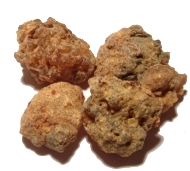
Photo from wikipedia
ABSTRACT Introduction Frankincense (Boswellia sp.) gum resins have been employed as an incense in cultural and religious ceremonies for many years. Frankincense resin has over the years been employed to… Click to show full abstract
ABSTRACT Introduction Frankincense (Boswellia sp.) gum resins have been employed as an incense in cultural and religious ceremonies for many years. Frankincense resin has over the years been employed to treat depression, inflammation, and cancer in traditional medicines. Areas covered This inclusive review focuses on the significance of frankincense diterpenoids, and in particular, incensole derivatives for establishment future treatments of depression, neurological disorders, and cancer. The authors survey the available literature and furnish an overview of future perspectives of these intriguing molecules. Expert opinion Numerous diterpenoids including cembrane, prenylaromadendrane, and the verticillane-type have been isolated from various Boswellia resins. Cembrane-type diterpenoids occupy a crucial position in pharmaceutical chemistry and related industries because of their intriguing biological and encouraging pharmacological potentials. Several cembranes have been reported to possess anti-Alzheimer, anti-inflammatory, hepatoprotective, and antimalarial effects along with a good possibility to treat anxiety and depression. Although some slight drawbacks of these compounds have been noted, including the selectivity of these diterpenoids, there is a great need to address these in future research endeavors. Moreover, it is vitally important for medicinal chemists to prepare libraries of incensole-heterocyclic analogs as well as hybrid compounds between incensole or its acetate and anti-depressant or anti-inflammatory drugs.
Journal Title: Expert Opinion on Drug Discovery
Year Published: 2022
Link to full text (if available)
Share on Social Media: Sign Up to like & get
recommendations!